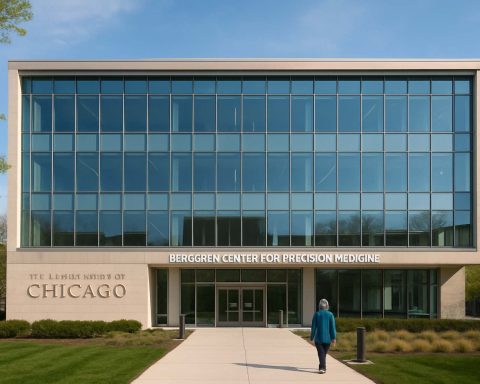- The University of Maryland launches the Maryland Institute for Quantum Applications, aiming to revolutionize national security with quantum technology.
- This initiative is housed within the Applied Research Laboratory for Intelligence and Security (ARLIS), a hub of defense innovation.
- Maryland’s “Capital of Quantum Initiative” includes a $1 billion investment to advance quantum research, with $25 million dedicated to ARLIS.
- Quantum computing, networking, and sensing are emerging as critical tools for defense, poised to address complex security challenges.
- Governor Wes Moore supports aligning state and federal efforts, enhancing Maryland’s leadership in quantum fields.
- The RISC internship at ARLIS fosters future defense and intelligence leaders through hands-on experience.
- UMD President Darryll J. Pines emphasizes the institute’s role in integrating quantum advances for national benefit.
- The search for a director is underway to guide the Maryland Institute for Quantum Applications towards impactful defense solutions.
Nestled within the bustling academic enclave of College Park, the University of Maryland (UMD) is embarking on a journey that promises to redefine the frontiers of national security. With the recent announcement of the Maryland Institute for Quantum Applications, a seismic shift towards harnessing quantum technologies for defense is on the horizon. Fittingly, this institute will reside within the storied Applied Research Laboratory for Intelligence and Security (ARLIS), an epicenter of innovation focused solely on fortifying intelligence and security.
UMD’s history with quantum science is long and storied, and the establishment of this new center is a natural progression in its quest for technological supremacy. Quantum computing, networking, and sensing are no longer distant ambitions. Instead, these are tangible tools, poised to transform strategic defense capabilities and furnish modern solutions for intricate security challenges. The question isn’t if quantum technologies will be integral but rather how swiftly they will be adopted. This is a realm where photons, qubits, and entanglement converge to create untapped potential for robust national defense.
The announcement is bolstered by Maryland’s ambitious “Capital of Quantum Initiative,” a strategic vision propelled by a staggering $1 billion investment to solidify the state as a vanguard in quantum research and development. With Governor Wes Moore’s proactive endorsement, the synergy between state efforts and federal objectives becomes a beacon for aspiring quantum pioneers.
A significant influx in funding—nearly $25 million earmarked for quantum advancements—underscores ARLIS’s pivotal role in this quantum quest. Here, cutting-edge research and development are routine, ensuring the state remains at the forefront of quantum exploration. The lab’s notable Research for Intelligence & Security Challenges (RISC) internship program not only nurtures the next generation of thinkers but also seamlessly integrates young minds into real-world defense and intelligence conundrums.
As the visionary University President Darryll J. Pines elucidates, the creation of the Maryland Institute for Quantum Applications epitomizes the university’s commitment to leveraging its unparalleled expertise for the nation’s benefit. This is more than an academic exercise; it’s an assertion of Maryland’s pivotal role in global security concerns, a stratagem to weave quantum’s intricate threads into the very fabric of national defense.
In the coming months, the search for a director will add another layer to this unfolding narrative, ensuring that the institute is helmed by a visionary equipped to translate quantum promise into strategic defense realities.
Through ARLIS, UMD is meticulously scripting a future where quantum technologies are indispensable allies in national security—a narrative where Maryland stands at the helm, readying its arsenal of quantum innovations for the challenges ahead.
The Quantum Leap in National Security: How UMD is Pioneering Quantum Technologies
Introduction: UMD’s Quantum Frontier
The University of Maryland (UMD) is making waves in the realm of national security with the launch of the Maryland Institute for Quantum Applications. This new initiative, housed within the Applied Research Laboratory for Intelligence and Security (ARLIS), is set to push the boundaries of quantum technology in defense. UMD’s deep-rooted history in quantum science and the establishment of this center indicate a commitment to harnessing cutting-edge technologies for strategic defense applications.
Why Quantum Technologies Matter
Key Features of Quantum Technologies:
– Quantum Computing: Solves complex problems exponentially faster than classical computers.
– Quantum Networking: Offers secure communication channels resistant to eavesdropping.
– Quantum Sensing: Enables sensitive detection methods that can be used in fields like geolocation and navigation.
Security Implications:
Quantum technologies promise to revolutionize national security by providing new tools that enhance intelligence operations, secure communications, and improve surveillance capabilities.
Insights & Predictions
UMD’s new quantum center is expected to be a game-changer in the following ways:
– Research and Development: With almost $25 million dedicated to quantum advancements, the focus will be on pioneering research that addresses intelligence and security challenges.
– Talent Pipeline: The RISC internship program is critical in fostering the next generation of quantum researchers, ensuring a steady stream of innovative talent ready to tackle real-world problems.
– Global Influence: As quantum technologies become integral to national defense, UMD’s efforts position Maryland as a global leader in this domain.
How-To Steps & Life Hacks
If you’re interested in the rapidly evolving quantum field, here are steps to align yourself with this technological shift:
1. Educate Yourself: Gain foundational knowledge in quantum mechanics and related technologies.
2. Pursue Relevant Courses: Enroll in programs or online courses that offer exposure to quantum computing and security.
3. Stay Updated: Follow developments in quantum research and understand their real-world applications.
4. Network: Connect with professionals and academics involved in quantum research, such as through conferences or seminars.
5. Hands-On Experience: Explore opportunities like internships or research assistant roles, especially in institutions like UMD.
Market Forecasts & Industry Trends
With a $1 billion investment backing Maryland’s “Capital of Quantum Initiative,” the state is poised to become a hub for quantum innovation. Here are key market forecasts:
– Investment Growth: Expect increased funding from both government and private sectors as quantum applications grow.
– Commercialization: Beyond defense, sectors like telecommunications, finance, and logistics are likely to leverage quantum technologies.
– Job Market: Demand for skilled professionals in quantum computing and related fields will surge, potentially leading to educational programs adapting to meet workforce needs.
Pros & Cons Overview
Pros:
– Enhanced computational power for complex problem-solving.
– Secure communication through quantum encryption.
– Advanced sensors for improved detection and tracking.
Cons:
– High costs associated with research and development.
– Limited availability of quantum computing resources.
– Complexity in integrating quantum systems with existing infrastructure.
Conclusion & Actionable Recommendations
To capitalize on these advancements, here are quick tips:
– For Students: Explore courses in quantum computing and participate in internships to gain practical experience.
– For Businesses: Investigate potential applications of quantum technologies in your field and consider partnerships with research institutions like UMD.
– For Policymakers: Support policies and funding initiatives that encourage quantum research and education.
Stay connected with the latest in quantum technologies by visiting UMD’s official website, a leader in this transformative field.








